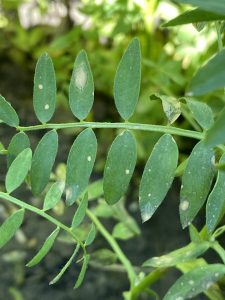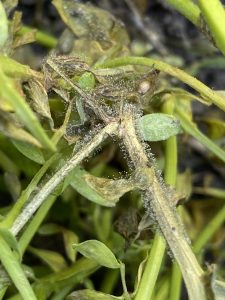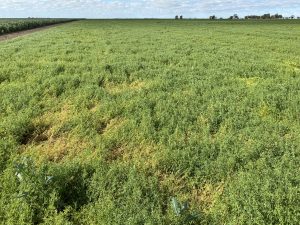Botrytis grey mould (BGM) has been reported in multiple lentil crops in Victoria. These reports were prior to canopy closure in varieties with a moderately susceptible or susceptible resistance rating. Growers are encouraged to check their crops for symptoms and proactively control for disease. Early intervention is critical to minimise damage as this disease can develop rapidly with the right weather conditions. If symptoms are visible, then fungicide application is recommended, even pre-canopy closure.
If no symptoms are visible pre-canopy closure, then the preventative fungicide at canopy closure as per normal recommendations should provide adequate protection against botrytis grey mould in lentils. If rainfall continues a follow up fungicide may be necessary.
The same pathogen that causes BGM in lentil also causes BGM in vetch. Therefore, vetch crops can act as a reservoir and spread from vetch to lentil crops. All vetch varieties are susceptible to botrytis grey mould. Growers are encouraged to consider the end use of the crop when making fungicide decisions, in addition to the adjacent crops.
With recent wet conditions, all pulses growers will need to be pro-active with their disease management. This applies to all diseases in all crops. It is advisable to check the latest disease ratings and the relevant definitions for the disease ratings in the Victorian Pulse Disease Guide 2021.

Early stage of Botrytis grey mould infection on lentil leaves. Photo: Josh Fanning, Agriculture Victoria

Botrytis grey mould infection on lentil, showing later stage infection with grey fluffy mould. Photo: Josh Fanning, Agriculture Victoria
Further information
Identification & Management of Field Crop Diseases in Victoria
CropAlert – Pulse Disease Update September 2020
Horsham Field Crop Diseases research group (Agriculture Victoria)
For further information and assistance in diagnosing botrytis grey mould, contact the Horsham Field Crop Diseases research group.
Ph: (03) 4344 3111
Email: [email protected]
Kind regards,
The Horsham Field Crop Pathology and CropSafe teams



